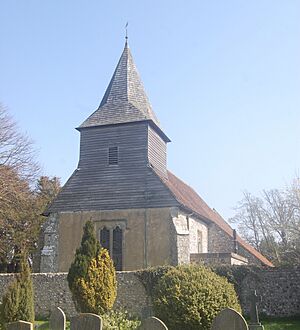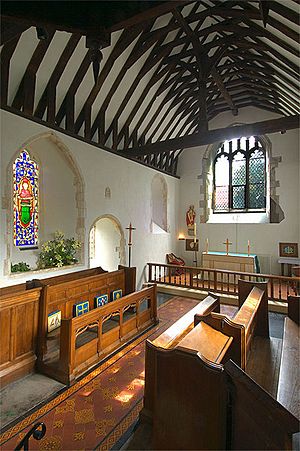St Mary and St Peter's Church, Wilmington facts for kids
Quick facts for kids St Mary and St Peter's Church, Wilmington |
|
|---|---|

West end of the church in 2022 showing the wooden bellcote
|
|
| Lua error in Module:Location_map at line 420: attempt to index field 'wikibase' (a nil value). | |
| OS grid reference | TQ 544,043 |
| Location | Wilmington Street, Wilmington, East Sussex BN26 5SL |
| Country | England |
| Denomination | Anglican |
| Churchmanship | Central Anglican |
| Website | St Mary and St Peter, Wilmington |
| History | |
| Status | Parish church |
| Architecture | |
| Functional status | Active |
| Heritage designation | Grade I |
| Designated | 30 August 1966 |
| Architect(s) | Paley and Austin (restoration) |
| Architectural type | Church |
| Style | Norman, Gothic, Gothic Revival |
| Administration | |
| Parish | Wilmington |
| Deanery | Lewes and Seaford |
| Archdeaconry | Lewes and Hastings |
| Diocese | Chichester |
| Province | Canterbury |
St Mary and St Peter's Church is a beautiful old church in the village of Wilmington, East Sussex, England. It's an active Anglican church, meaning it's still used for services today. The church is part of the diocese of Chichester.
This church was first built around the late 1000s. It served the local villagers and also monks from the nearby Wilmington Priory. The church and priory were even connected! Over many years, the church has been carefully repaired and updated. Famous architects Paley and Austin worked on it in the Victorian era. After a fire in the early 2000s, the inside was also made new again. St Mary and St Peter's Church is very important. It is listed as a Grade I building, which means it has special historical value.
Contents
A Look Back: The Church's History
After the Norman Conquest in 1066, monks from a French monastery called Grestain Abbey came to Wilmington. They started Wilmington Priory to manage their land. Only a few monks lived there. They didn't build their own church. Instead, they shared the main part of the village church, called the chancel.
The church was built by the year 1100. It served the farmers and people of Winelton, as the village was known then. A covered walkway, called a cloister, connected the church to the priory. In 1414, King Henry V closed down many small monasteries like Wilmington Priory. After that, the church became only a parish church for the village.
There's a huge yew tree in the churchyard. Scientists say it's about 1,600 years old! This suggests that people thought this spot was special even before Christianity. Inside the church, there's a unique stone figure called the Wilmington Madonna. It used to be outside. Some people think it might show that ancient people worshipped other gods here.
In the 1200s, a small chapel or transept was added on the north side. A south aisle was also built. This aisle looked like another transept. It was separated from the main church by two arches. The main part of the church, the nave, was rebuilt in the 1300s.
Later, in the 1400s, a north porch was added. A new window was also put in at the east end. Strong supports called buttresses were added to the east end around this time. This was probably because new windows had made the walls weaker.
Between 1882 and 1883, the church was restored by architects Paley and Austin. They made the south aisle longer. They also removed a gallery at the west end. New floors, an altar, and seating were put in. They also fixed the north transept. A fancy arch was added to the chancel. This restoration cost about £1,790.
In 2002, a fire badly damaged the north transept, which was used as a vestry. The organ was destroyed. The church was repaired and reopened in 2004. A beautiful stained glass window showing butterflies and bees was damaged in the fire. A new window was made with the same theme. It also included images of Saint Peter and a phoenix rising from flames.
Church Design: Architecture and Features
The church has a main area called the nave. It has a porch on the north side. There's also a south aisle, a north transept, and the chancel. The walls are made of flint stone. They are very strong. The window openings are wide on the inside to let in more light.
At the west end of the church, there's a lovely wooden bellcote. It has a pointed roof covered with shingles. The chancel is from the Norman period. It has two original round-topped windows. There are also signs of a round-topped doorway on the south side.
The windows in the nave are in the Decorated Gothic style. The east window is in the Perpendicular Gothic style. You can see signs of decorative arches around some windows. This is also seen at St Michael and All Angels Church nearby. The tall chancel arch was added by Paley and Austin. It looks like it's from the 1200s. The church also has a special roof structure called a king post roof.
Inside the church, the wooden pulpit is from around 1610. It has a back panel and a special canopy above it. This fancy pulpit looks very different from the simple Norman style of the church. The font is from the 1300s. It's a plain square bowl on a central column with four smaller columns.
In the chancel, there are two square cupboards called aumbries. On the north chancel wall, there's an old stone sculpture. It's from the 1000s or 1200s. It was moved inside in 1948. On the north wall of the nave, you can still see parts of a painted message from the 1600s. On the south wall, there's a painted panel with the Royal arms of Queen Victoria.
An old monument from the Elizabethan era (late 1500s) is in the south aisle. It has details from Classical styles. A very unusual feature from the church's earliest days is a set of stone seats. They are built into the inner walls of the chancel and face inwards. These kinds of benches were common in churches from the 1000s. But usually, they were removed during later repairs.
The Church Today
St Mary and St Peter's Church was given a Grade I listing on August 30, 1966. This means it's considered a building of "exceptional interest" and is very important to the country's history. As of February 2001, it was one of 47 Grade I listed buildings in the Wealden District.
The church serves a small village area north of the South Downs. About 200 people live in this area. The main A27 road runs through it. The church is part of a group of five churches called a benefice. This group includes churches in Arlington, Berwick, Selmeston-with-Alciston, and Wilmington. A rector and an assistant priest lead services for all these churches. Each church also has its own churchwardens.
Services are held on Sunday mornings. They use the Book of Common Prayer every other week. On alternate Mondays, there is also an Evening Prayer service.
See also
- Grade I listed buildings in East Sussex
- List of current places of worship in Wealden
- List of ecclesiastical works by Paley and Austin



